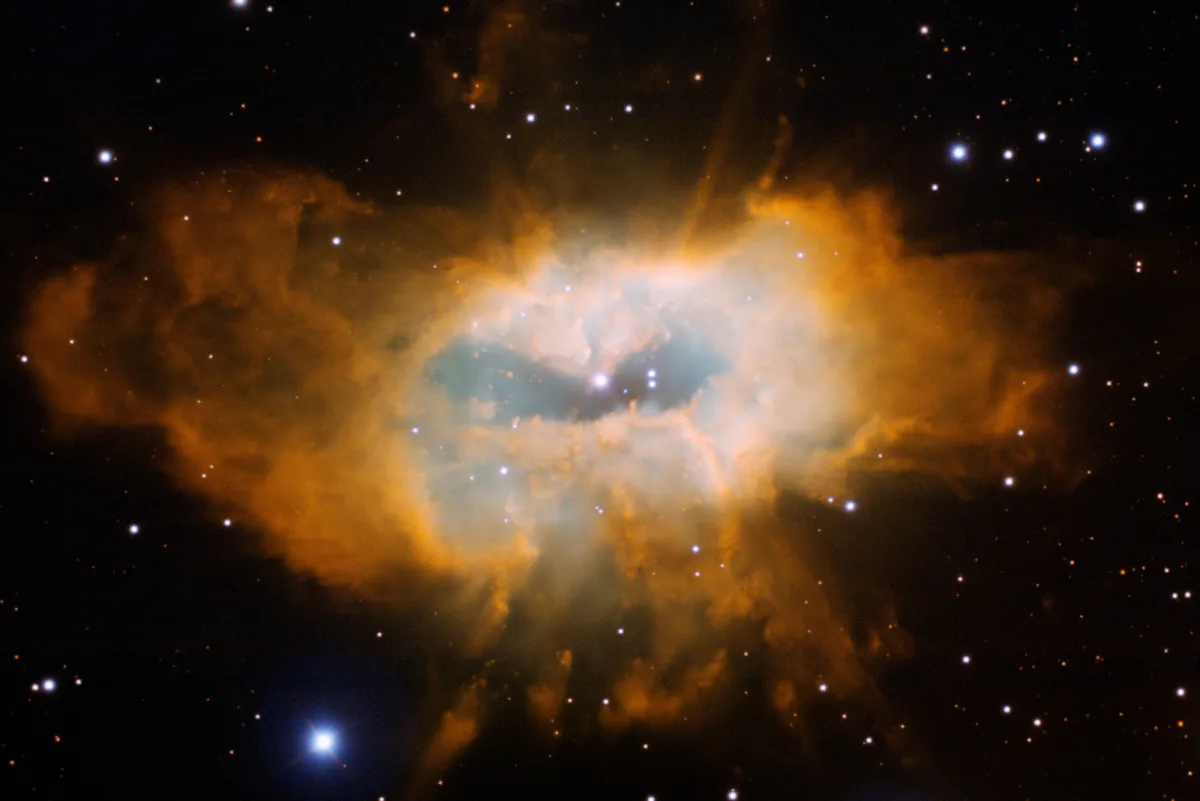Planetary Nebula Sh 2-71

History
This nebula was discovered in 1946 by Rudolph Minkowski (Min 1-90) and classified as «diffuse and peculiar nebulosity». [397] Later in 1959 it was included in the catalogue of H-II by Stewart Sharpless. He already noted that nebula may also be a planetary nebula. [310]
In 1961 the Soviet astronomer Boris Aleksandrovich Vorontsov-Vel'Yaminov confirmed Sh 2-71 (V-V 1-9) to be a planetary nebula and noted: «Overexposed in the red, with a kind of dark band in the middle and with extremely faint appendages; the edge, however, is sharp. The brigt part measures 2.5' x 1.3'. In the blue, this is evidently a planetary nebula in the form of a broad ring, one-half of which is far brighter than the other. There are two stars in the centre, one of which should be the nucleus.» [390]
Physical Properties
The unusual elongated appearance of this planetary nebula was probably caused by a triple star system that has later broken apart. The third component was a long-period orbiting a binary central star. Deep exposures reveal a presence of extended regions of emission to the east and west of the central nebula. [623] Given distances vary between 1 and 1.7 kpc. Apparent magnitudes with different filters: B 14.69; V 14.0; R 13.66; J 12.002; H 10.94; K 9.483. [145]
| Designations | PN G035.9-01.1: Sh 2- 71, PK 36-01.1, ARO 31, V-V 1-9, VV'473 |
| Right Ascension (J2000.0) | 19h 01m 00s |
| Declination (J2000.0) | +02° 09' 23" |
| Dimensions | 100." (optical), 114." (radio) |
| Radial Velocity | +24.7 ± 3.0 km/s |
| Expansion Velocity | 16.0 (O-III) 21.5 (N-II) km/s |
| C-Star Designations | AG82 339 |
| C-Star Magnitude | U: 14.97, B: 14.59, V: 13.75 |
| C-Star Spectral Type | B |
| Discoverer | SHARPLESS 1959 |
Finder Chart
The planetary nebula Sh 2-71 can be found in the constellation Aquila. The position is easily determined by the bright surrounding stars of 6th to 7th magnitude within a 1° field of view. On 7 July it is in opposition to the Sun and culminates at local midnight. The best observing time are the months March to December.
Visual Observation
400 mm Aperture: In the 21 mm Ethos eyepiece (85x), the PN is visible as a faint, round nebula even without a filter using averted vision. With the O-III filter, the dark spot in the middle can be identified. — 400 mm f/4.5 Taurus Dobsonian, Hasliberg, 18. 8. 2023, SQM 21.2, Bernd Nies
762 mm Aperture: This planetary nebula lies in a star triangle as a knotty arc. With an OIII filter, structure and nodes are visible. The shape shows a resemblance to an embryo ultrasound image, as the antenna galaxies NGC 4038/9 also visually suggest. — 30" SlipStream-Dobson f/3.3, Hasliberg, 18. 8. 2023, Eduard von Bergen
